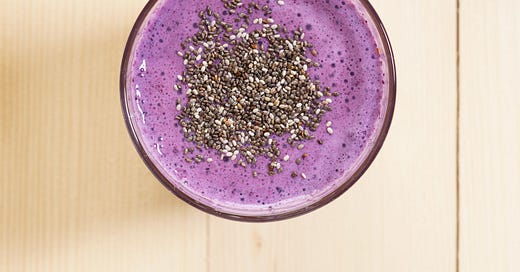I was diagnosed with ADHD at 38. Finally.
+ The Midst in SELF • Why we've jumped on the chia seeds bandwagon
Why are chia seeds one of the best superfoods and superseeds?
While I’m usually anti-superfads, I am a sucker for superfoods and try to eat as many as possible (looking at you, almonds, berries, and kale). Then when I heard Jennifer Aniston and Taylor Swift are chia seeds fans, I became intrigued and bought a pound of them.
A month after eating chia seeds daily, I’m here to report good news: I don’t even notice them in my daily smoothies, and I’ve managed to lose a couple of pounds without changing anything else about my diet.
After doing a ton of research on chia seeds, I’ve written this guide to highlight just about everything you need to know about the superseeds — and then some.
What are the health and nutritional benefits of chia seeds?
Health benefits of chia seeds range fom improved digestion, weight management, and increased energy — here are four to write home about.
1. ALA fatty acid supports heart health
According to the Harvard School of Public Health, chia seeds are the richest plant source of omega-3 fatty acids and contain all nine essential amino acids that cannot be made by the human body.
Even though I eat healthily, I inherited high cholesterol, so I was happy to learn that chia seeds help to reduce triglycerides and can lower blood pressure and inflammation. I’m also not a big meat eater, so I think of chia seeds as a heart-smart way to get ALA (Alpha-linolenic acid) fatty acid, also a primary nutrient in walnuts.
The Nurses’ Health Study found a 40% reduced risk of sudden cardiac death in women who ate the highest amounts of ALA. Another study of 5,000 men and women 65+ found that eating more ALA was associated with a 50% reduced risk of fatal ischemic heart disease.
2. Dietary fiber promotes regularity, feeling full, and stable blood sugar levels
Eating chia seeds regularly can promote better gut health thanks to both soluble and insoluble fiber:
Soluble fiber absorbs water and forms a gel-like substance in the gut, which can help slow down digestion and keep you feeling fuller for longer. Soluble fiber also has been shown to improve blood sugar levels in some people with diabetes, according to UCSF Health. Master nutritionist therapist Kerri Ferraioli agrees and says the high fiber content of chia seeds can help with weight management.
Insoluble fiber adds bulk to the stool (sorry, had to say it) and helps to prevent constipation.
How much fiber is in chia seeds?
One ounce of chia seeds contains about 10 grams of fiber, which is a hefty portion of the daily recommended intake of 25 to 30 grams a day from food, not supplements. Fiber is essential for digestive health, going to the bathroom regularly, and the growth of healthy gut bacteria.
3. Antioxidants protect cells from the harm caused by free radicals
The antioxidants in chia seeds are the bodyguards that neutralize free radicals, reducing the risk of cellular damage and promoting overall health. Yep, chia seeds can help fight against age-related diseases and inflammation.
Thanks to SELF for featuring us in this story about dealing with perimenopause symptoms
SELF published this story about seven women going through perimenopause and how they’re dealing with the symptoms (hooray!). Women’s answers ranged from pilates to hormone therapy to strict sleeping schedules. I talked about writing about my frustrations. Here’s the clip:
About seven years ago, Amy Cuevas Schroeder, 48, started having “extreme night sweats and insomnia,” along with midsection weight gain, irritability, and sore muscles and joints, she tells SELF. She’d often wake up at 2 a.m. covered in sweat. After researching her symptoms, she realized it was likely perimenopause, but her general practitioner and ob-gyn dismissed her symptoms since she was still having periods.
Schroeder, a tech content strategist based in Phoenix, wrote about her struggles on her blog, which became The Midst, a health and wellness platform for women in midlife. This has given her an outlet to share her story and connect with other women going through perimenopause, she says. “I think it’s helpful to share notes—especially since there are dozens of symptoms that women could experience and sometimes it’s hard to know which are caused by hormone changes.”
Schroeder says her blog led to her being quoted about perimenopause in the Chicago Sun-Times and connecting with the Northwestern Medicine Center for Sexual Medicine and Menopause. Her new care team said she was in perimenopause and prescribed progesterone, which made her night sweats less frequent and severe, and trazodone (an antidepressant) to help her sleep. She now also uses an estrogen patch to keep symptoms at bay.
In May, we’re celebrating Mental Health Awareness Month by sharing some of our recommended stories about mental health and wellness.
Why are women with ADHD slipping through the cracks?
I'll never forget the time in grade school when my mother took me to a wallpaper store. While there, a woman brought her two children, who happened to be my classmates.
The mother — let’s call her Theresa — left the store without her children. She returned, of course, to retrieve them, exasperated and embarrassed by the blunder. My mom and I were taken aback. How could a mother do such a thing? How could your own offspring be an afterthought?
Now, 30 years later, I filter this encounter through a different lens: Did Theresa have Attention-Deficit/Hyperactivity Disorder (ADHD)? I’ll never know for sure, but I think it’s a very solid theory.
Spacey and scatterbrained? Or a seriously debilitating attention disorder?
As I navigate my own ADHD diagnosis, I wonder how many Theresas are out there: Women whom society views as flaky, lazy or spacy but in reality, they struggle with executive function and short attention spans.
Over my life, I’ve experienced plenty of stigma around ADHD that has left me feeling “less than.” For instance, I’m chronically late due to time blindness. I have baking horror stories. (Just ask my mom about the infamous chocolate chip cookies/bricks.) I routinely misplace important documents. I get overstimulated and overwhelmed in contexts when multiple people are peppering me with questions back to back. I leave the house without my keys each week more times than I’d like to admit. In other words, the struggle is real, despite modern interventions.
Recently, a college friend told me, “I don’t consider ADHD a mental health disorder.” Ouch. Despite attitudes like these, I am grateful that clinicians recognize it as a legitimate disorder and that help is available for the millions of us ADHD’ers in the United States.
Yet, despite the rapid pace of medical advancement, they are still often left on the sidelines. Academics believe gender bias can lead to misdiagnosis and underdiagnosis of ADHD in women and girls. Boys receive ADHD diagnoses much more often than girls, according to the Centers for Disease Control and Prevention (CDC). The contrast is stark — 12.9% vs. 5.6% for women.
Looking for a good book? Check out some of our recommended reads on Bookshop.












I love adding chia seeds to my Greek yogurt along with banana, honey, and granola. This is my go-to breakfast (or dessert, depending on the day) and I've noticed a marked improvement in my digestion and satiety. (Also, I kinda like the texture of chia seeds. Am I alone in that?!)
I'm a big fan of chia seeds and also flax seeds. I sometime sprinkle chia seeds on these crackers to double-up: https://www.amazon.com/Doctor-Kitchen-Flackers-Crackers-Variety/dp/B01MZIHO8Z/ref=asc_df_B01MZIHO8Z?mcid=366045e84f403847acc42f5c2c6444d1&hvocijid=2427251282518507980-B01MZIHO8Z-&hvexpln=73&tag=hyprod-20&linkCode=df0&hvadid=721245378154&hvpos=&hvnetw=g&hvrand=2427251282518507980&hvpone=&hvptwo=&hvqmt=&hvdev=c&hvdvcmdl=&hvlocint=&hvlocphy=9198466&hvtargid=pla-2281435180738&psc=1